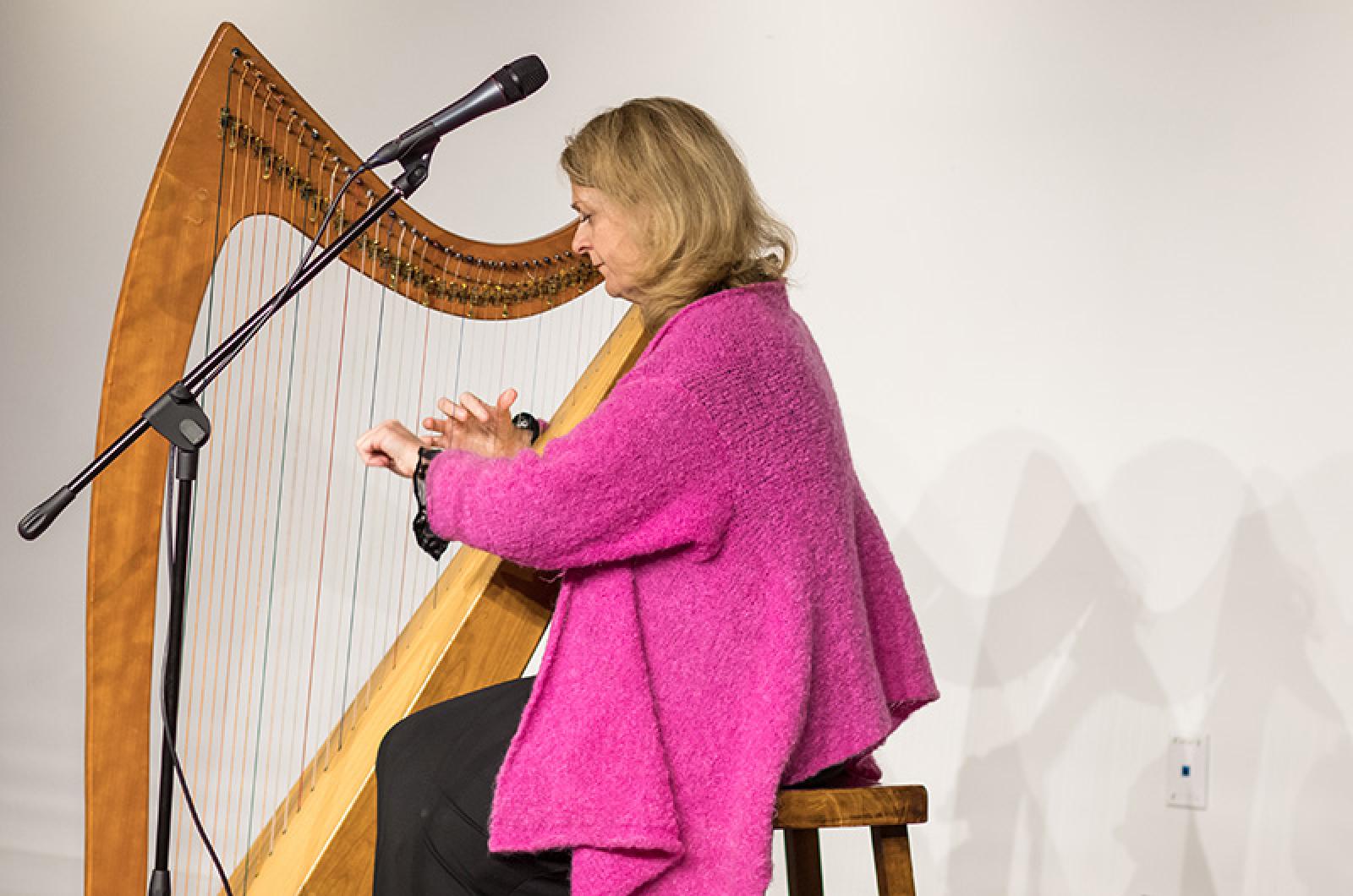In Mexico and much of Latin America, they call Oct. 31 Dia de los Muertos. In the Philippines, people travel house to house, singing and asking for alms on Pangangaluluwa, their celebration of All Saint’s Day. Even Romania has joined the fun with a Day of Dracula.
But the roots of Halloween also date back to the Celtic festival Samhain (pronounced sow-wan), an ancient celebration that occurs exactly halfway between the winter solstice and autumn equinox, marking the end of summer and the beginning of the year’s “darker half.”
At the Edgartown library on Saturday, internationally renowned Celtic harpist Aine Minogue honored Samhain and the coming of Halloween on Martha’s Vineyard with an elegant, and, at times, “otherworldly” performance of her own.
“Only the really strong come out on afternoons like today,” Ms. Minogue told the hardy audience who had braved Saturday’s inclement weather. “So I promise we’re going to go on a fun journey to celebrate this time of year, for one of my favorite seasons.”

And as the storm raged outside, listeners inside the library were treated to the magical serenity of Ms. Minogue’s harp and voice. Growing up in a family of Irish folk musicians, Ms. Minogue followed in the footsteps of her two sisters and started playing the instrument at age 12 while attending boarding school in Galway.
Currently, there are fewer than a dozen pre-1700 Celtic harps still in existence, and only a few more musicians skilled enough to play the tunes. Ms. Minogue’s songs seek to preserve traditions that predate Ireland. They are their own form of a ghost story.
“It is a fabulous instrument,” Ms. Minogue said. “Ireland has a lot of traditions, a lot of stories, and I want to share those with you today, through my harp.”
Within seconds, Ms. Minogue made her 27-pound, 47-string maple instrument spring to life. She opened with The Dove’s Return, a song she wrote earlier in her career and has gained international recognition.
“It paid for every appliance in my house,” Ms. Minogue joked.
She then moved on to more traditional Samhain tunes, reminding Vineyarders that their own summer season had closed, and that quieter days were ahead.
“In Samhain / The days grow dark and longer,” she sang. “I feel the winter’s chill / Until it’s gathered in / Until it’s gathered in.”
Her fingers danced over the harp’s strings while the rest of her body remained perfectly still. As her left hand plucked at the longer, deeper strings, with her palm often opening to dampen their sound, her right hand fluttered over the shorter, higher pitched ones. Every so often she adjusted knobs at the top of the instrument to change the strings by exactly half a key. There was an occasional gentle rock, a rare tap of the foot, but never an extraneous movement. With every song there came a story.
“The Selkie is one of those old Irish songs, telling a story where nobody wins,” Ms. Minogue said. The song is about a male seal who can shed its skin to obtain human form, coming on land and marrying a mortal woman. When he gets his skin back, he can’t resist the lure of the sea, leaving himself, and the mother of his child, crying on the shore.
Other songs were more humorous than heartbreaking. Were You At The Rock refers to the early years in Irish history, when priests had to conduct secret masses on natural rock altars.
“The song is very allegorical, which makes it very Irish,” Ms. Minogue said. “The parishioners would sing certain songs to signal to each other, which went, were you at the rock, and did you see my love, and did you see my valentine? And you think an Irishman is going around looking for his valentine. So be very careful whenever an Irishman speaks to you, because you really have no idea what he is saying.”
Ms. Minogue finished with songs about faeries, ghosts and most spookily, banshees, the harbingers of death in ancient Irish lore.
“You’re Martha’s Vineyarders, in the thick of a hurricane,” she told the audience before breaking into the Song of the Banshee. “I know you can handle another strange song because you’re all hardcore here.”
According to Irish tradition, mourners would sing the song of the banshee to signal someone’s death.
“I always play this one during Samhain,” Ms. Minogue said. “All these great traditions, when you scratch them, they often have a beautiful folkloric function. The song of the banshee is about acknowledging all the things that have come, all the losses one has had, but on the other hand, I’m always looking for the songs I haven’t heard yet, the songs the banshee are trying to sing for me.”




Comments
Comment policy »